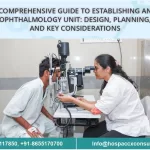Introduction
The central sterile services department (CSSD) is an integrated place in hospitals and other health care facilities that performs sterilization and other actions on medical devices, equipment and consumables. The operations of a sterile services department usually consist of the cleaning, disinfection, and sterilization of reusable medical equipment.
Considering the above facts, Hospaccx team participates in ‘Planning and Designing of Hospital CSSD’. This is macroficial study of radiology department planning and designing if you want to get into more detail you can contact https://hospaccxconsulting.com/
The sterilization department in a hospital is known by many acronyms, e.g.:
- CSD: Central Sterilization Department
- CPD: Central Processing Area
- SSD: Sterile Service Department
- TSSD: Theatre Sterile Service Department
- TSSU: Theatre Sterile Service Unit
Planning & Designing of CSSD
Structure of CSSD Department
- Location
For minimizing distance for transportation & also for saving time, CSSD should be located as near main user areas as possible like Operation Theatres, intensive care areas etc. Therefore, CSSD should be on the same floor or the floor immediately above or below.
While planning location, supply location i.e. linen store, laundry & general store can be planned in the vicinity of CSSD.
2. Area required for CSSD Department
Requirement of area depends mainly on work load, number of sterilizing equipments & turnover of the material.
Minimum area requirement is 7sq.ft. per bed(Minimum area of 100 sq. ft. is required if hospital is small).
Surface Area Calculation for CSSD:
- For >300 bedded Hospital: 0.7 m²/ No. of Beds
- For 300 to 600 bedded Hospital: 0.6 m²/ No. of Beds
- For <600 bedded Hospital: 0.5 m²/ No. of Beds
3. Functional Zones
Dirty Area (Area for soiled items)
Clean Area
Sterile Area
Support Area
The area within the CSSD can be sub-divided as follows:
| Area | Space |
| Dirty Area | 35% of the Surface Area |
| Clean Area | 35% of the Surface Area |
| Sterile Area | 20% of the Surface Area |
| Support Area | 10% of the Surface Area |
4. Floors
- Carpet or similar soft flooring should be avoided.
- Impermeable, non-slip floor covering is recommended. PVC welded sheet vinyl coved up the wall ensures a watertight hygienic surface which will withstand daily cleaning.
- Small-diameter coving puts undue stress on the floor vinyl and is prone to cracking over time. Larger diameter coving has the added advantage that in certain cases it prevents trolley wheels from being pushed against the wall, acting as an added wall protection.
5. Walls
- Walls should be washable, preferably cladded by welded sheet vinyl. Durable polyurethane wall finishes are rapidly appearing on the market and selected products could also be suitable in certain circumstances.
- Walls should be adequately protected against damage by loose equipment and wheeled traffic by buffer rails and corner guards, which should be appropriately sited to reflect the specifications of trolleys in use. Protruding elements of different trolleys are of varying height. This should be considered in the selection of wall protection.
6. Ceilings
A minimum below-ceiling height of 2 800mm is recommended. If ceilings are lower, precautions must be taken with respect to the arrangement and number of air vents as well as to the temperature of the air circulated. This below-ceiling height will have implications for the noise level prevailing within the CSSD. Ceilings should be:
- washable, impermeable and non-porous
- sealed to prevent ingress of airborne particles or other contaminants from the ceiling void
- resisstant to humidity in zones where steam and moisture may be encountered.
7. Windows
- The walls and partitions must feature as many glass panels as possible to facilitate supervision, and also to create a feeling of spaciousness.
- Windows to the outside are highly desirable in the working areas. However, these windows should be non-opening, sealed and preferably flush fitting, in order to prevent the windowsills from being used as storing space. If this is unavoidable, the sills should be angled.
8. Doors
- Doorways should be positioned to allow trolley movement, and doors and corridors should be wide enough to accommodate trolley turning circles and protruding trolley fittings.
- Door frames and door leaves should be designed and finished with protection cladding and bumper rails to withstand the inevitable bumps by trolleys.
- Doors should be adequately sized to allow clear passage of current as well as possible future equipment.
- Automatic/semi-automatic doors make it easier for collection and distribution of trolleys. If not automated doors should be self-closing. If the design allows it, doors should open towards the higher pressure side where possible to overcome problems with weakening door closers, which may lead to lock-outs.
- Vision panels should be provided.
9. Sterile storage shelving
- Packs should be stored away from direct sunlight and water and should not be stored next to or under sinks, or on the floor where they are likely to get wet or damaged. Sterile packs should be stored at least 250 mm above the floor, and 450mm below the ceiling or sprinkler heads and at least 50 mm from side walls to allow for air circulation in the room and to prevent contamination during cleaning. The shelves should be 400mm apart and be adjustable in increments of about 50mm.
- Shelving should be stainless steel, slatted, 375mm deep, easily cleaned and allow air to circulate around stored packs. Freestanding or mobile shelving provides a practical solution for handling the flow of products in and out of storage and cleaning. It allows staff to access all sides of the storage area for rotation of sterile packs. Open shelving is more commonly used as it allows dust to pass through making them easier to clean than solid shelves.
10. Worktop furniture
- Work benches for standing activities should have a worktop height of 900mm and be constructed of stainless steel. Furniture should be movable with height adaption facilities.
11. Hand-wash basins
Hand washing remains one of the most significant ways in which cross-infection through contact can be avoided. To enhance this, staff should be aware of its importance and hand-wash facilities should be available in appropriate places and be accessible.
Conclusion
To conclude, CSSD is an independent Department in hospital with facilitates to receive, clean, pack, disinfect, sterile, store & dispute contaminated material as well as instruments.
Are you planning to design Central Sterile Services Department? We can help you to design your dream project, below are the healthcare design services that we offer:-
- Healthcare Architecture Design services
- MEP Design
- Landscape Design services
- Structural Design services
- Interior Design services
It is the superficial and macro level study for more details kindly contact Hospaccx Healthcare business consulting Pvt. ltd on hospaccx.india@gmail.com or you can visit our website on https://hospaccxconsulting.com
Related Team Members










